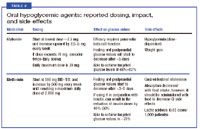Grand Rounds: Oral hypoglycemic agents in pregnancy.
Most studies suggest that certain oral hypoglycemic agents can be safely used in pregnancy. If patients are unable to commit to or be adherent to insulin therapy, oral glyburide may be an appropriate alternative.

Key Points
By Carol A. Majors, MD, for the Society for Maternal-Fetal Medicine

Women with diabetes are at greater risk for pregnancy-related complications like spontaneous abortion, preterm birth, preeclampsia, congenital malformations, stillbirth, macrosomia, birth trauma, and cesarean delivery. Many of these complications have been statistically linked with maternal hyperglycemia, which may cause fetal hyperglycemia and fetal hyperinsulinemia, and in turn result in delayed maturation, neonatal hypoglycemia, hypocalcemia, hypomagnesemia, and hyperbilirubinemia.4-6

Oral hypoglycemic agents are the mainstay for the treatment of nonpregnant type 2 diabetics. Since both gestational diabetics and pregnant type 2 diabetics suffer from insulin resistance, inadequate insulin secretion, or both, oral hypoglycemic agents may be an appropriate alternate or adjunct therapy to insulin during pregnancy.21
What exactly are the risks of oral hypoglycemic drugs in pregnancy?
There are five classes of oral hypoglycemic agents-sulfonylureas, biguanides, meglitinides, α-glucosidase inhibitors, and thiazolidinediones. In the past, experts have not recommended oral hypoglycemic agents for pregnant diabetics because of concerns about transplacental passage and the possibility of fetal teratogenesis, hyperbilirubinemia, neonatal hypoglycemia, and polycythemia (Table 1).22-25

In one retrospective study, 20 type 2 diabetics exposed to oral hypoglycemic agents during embryogenesis were compared with 40 type 2 pregnant diabetic women not exposed to these agents.29 50% of exposed infants (n=10) had congenital malformations including hydrocele, ear anomalies, single umbilical artery, cardiac defects, vertebral abnormalities, and anencephaly, compared with 15% in the unexposed group. The main problem with these studies was that the majority of women had poor glycemic control in the periconceptional period, and a number of the identified malformations could have been caused by the teratogenic effects of hyperglycemia itself.
On the other hand, no increased risk of fetal anomalies due to exposure to sulfonylureas and metformin had ever been identified in reports from South Africa, where both of these agents are used extensively.30-32 In a randomized, controlled 1971 trial, for example, the rate of fetal anomalies was similar in type 2 diabetic patients receiving first-generation sulfonylureas, when compared with that of patients receiving insulin.33 As many of the cases date back 30 years or more (when diabetes care was much less rigorous), the data from these studies must be interpreted with caution.
